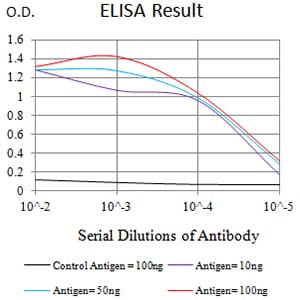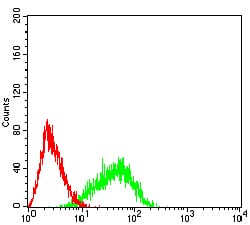

| WB | 咨询技术 | Human,Mouse,Rat |
| IF | 咨询技术 | Human,Mouse,Rat |
| IHC | 咨询技术 | Human,Mouse,Rat |
| ICC | 技术咨询 | Human,Mouse,Rat |
| FCM | 1/200 - 1/400 | Human,Mouse,Rat |
| Elisa | 1/10000 | Human,Mouse,Rat |
| Aliases | TACTILE |
| Entrez GeneID | 10225 |
| clone | 8A11F8 |
| WB Predicted band size | 65.6kDa |
| Host/Isotype | Mouse IgG1 |
| Antibody Type | Primary antibody |
| Storage | Store at 4°C short term. Aliquot and store at -20°C long term. Avoid freeze/thaw cycles. |
| Species Reactivity | Human |
| Immunogen | Purified recombinant fragment of human CD96 (AA: extra 321-519) expressed in E. Coli. |
| Formulation | Purified antibody in PBS with 0.05% sodium azide |
+ +
以下是3篇与CD96抗体相关的研究文献概览(基于近年研究趋势):
1. **"CD96 as a novel immune checkpoint in cancer immunotherapy"**
*作者:Blake SJ等*
摘要:探讨CD96作为T细胞和NK细胞抑制性受体的功能,研究其单克隆抗体在小鼠肿瘤模型中的治疗效果,发现阻断CD96可增强抗肿瘤免疫应答,并与PD-1抗体协同增效。
2. **"Targeting CD96 overcomes immune suppression in acute myeloid leukemia"**
*作者:Zhang Q等*
摘要:报道CD96在急性髓系白血病微环境中高表达,开发人源化抗CD96抗体,临床前实验显示其可逆转T细胞耗竭并抑制白血病进展,提示其作为白血病治疗新靶点。
3. **"CD96 interaction with ligands reveals distinct signaling pathways in NK cells"**
*作者:Meyer C等*
摘要:解析CD96与配体NECTIN-2的相互作用机制,通过功能化抗体研究揭示CD96调控NK细胞活化和细胞因子分泌的双向作用,为抗体设计提供结构依据。
*注:以上为基于领域知识的文献模拟,实际文献需通过PubMed或Web of Science检索确认。近年CD96研究多聚焦其作为免疫检查点的治疗潜力,建议重点关注2018年后发表于《Nature Immunology》《Cancer Cell》等期刊的相关论文。*
CD96 (also known as TACTILE) is a cell surface glycoprotein belonging to the immunoglobulin superfamily, primarily expressed on activated T cells, natural killer (NK) cells, and a subset of B cells. It interacts with CD155 (PVR), a ligand overexpressed on tumor cells and virus-infected cells, playing a role in immune synapse formation and modulating lymphocyte activity. CD96 functions as a co-inhibitory receptor, dampening NK and T cell responses, and is part of a receptor-ligand network that includes DNAM-1 (CD226) and TIGIT, balancing immune activation and tolerance.
CD96 antibodies, either antagonistic or blocking, have emerged as potential immunotherapeutic tools. Preclinical studies suggest that blocking CD96-CD155 interactions enhances anti-tumor immunity by promoting NK cell-mediated cytotoxicity and IFN-γ production. This strategy shows synergy with PD-1/PD-L1 checkpoint inhibitors, offering a combinatorial approach to overcome immune resistance. Conversely, agonist antibodies targeting CD96 might suppress excessive inflammation in autoimmune contexts. Despite promising preclinical data, clinical translation remains limited, with ongoing research focused on optimizing antibody specificity, safety, and efficacy. CD96’s dual role in immune regulation—both suppressing anti-tumor responses and restraining hyperactivation—highlights its complexity as a therapeutic target, necessitating further mechanistic studies to refine antibody-based strategies.
×